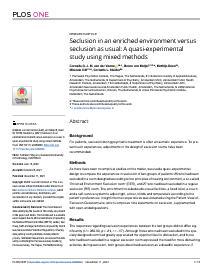Seclusion in an enriched environment versus seclusion as usual : A quasi-experimental study using mixed methods
Background
For patients, seclusion during psychiatric treatment is often a traumatic experience. To prevent such experiences, adjustments in the design of seclusion rooms have been recommended.
Methods
As there have been no empirical studies on the matter, we used a quasi-experimental design to compare the experiences in seclusion of two groups of patients: 26 who had been secluded in a room designed according to the principles of healing environment, a so called ‘Enriched Environment Seclusion room’ (EES), and 27 who had been secluded in a regular seclusion (RS) room. The enrichment included audio-visual facilities, a fixed toilet, a couch and a self-service system to adjust light, colour, blinds and temperature according to the patient’s preferences. Insight into their experiences was obtained using the Patient View-of-Seclusion Questionnaire, which comprises nine statements on seclusion, supplemented with open-ended questions.
Results
The responses regarding seclusion experiences between the two groups did not differ significantly (U = 280.00, p = .21, r = -.17). Although those who had been secluded in the specially designed room had greatly appreciated the opportunities for distraction, and those who had been secluded in a regular seclusion room expressed the need for more distracting activities during seclusion, both groups described seclusion as a dreadful experience. If seclusion cannot be avoided, patients recommend facilities for distraction (such as those provided in an enriched environment seclusion room) to be available.
Conclusion
Whatever the physical environment and facilities of a seclusion room, we may thus conclude that seclusion is a burdensome experience.
In: PLoS One ; ISSN: 1932-6203 | 16 | 11 | e0259620
https://doi.org/10.1371/journal.pone.0259620


